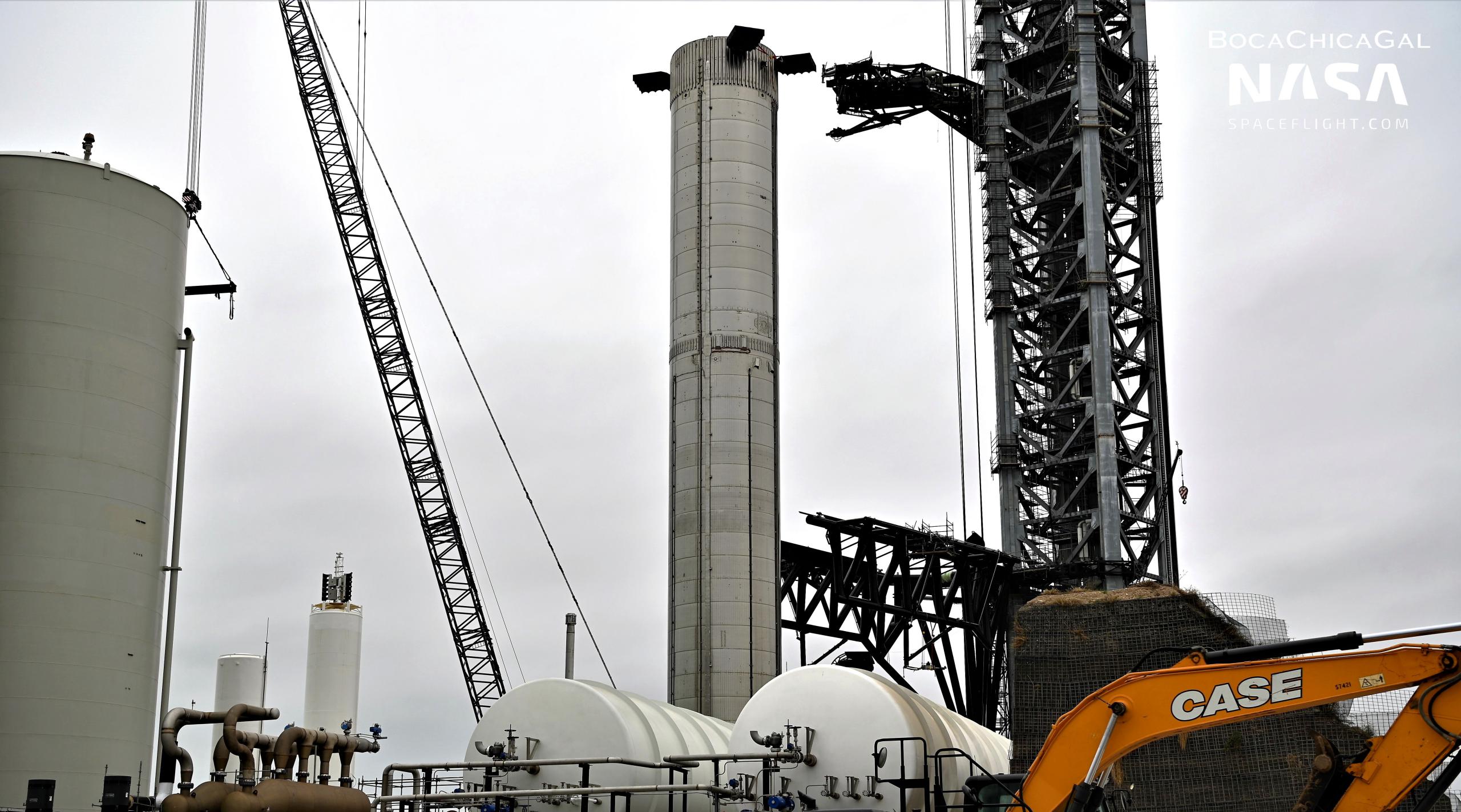

News
SpaceX rolls Super Heavy booster to orbital launch mount
For the third time in four months, SpaceX has rolled the first potentially flightworthy Super Heavy booster towards Starbase’s orbital launch mount.
Combined with a large crane – fitted with a jig solely used to lift boosters – moving to a spot just beside the booster, it’s clear that SpaceX is preparing to reinstall Super Heavy Booster 4 (B4) on the orbital launch mount. In the context of its unusual history, though, what happens next to the first more or less finished prototype of the largest rocket booster ever built is less clear.
After a shockingly quick assembly over the course of six summer weeks, Super Heavy Booster 4 rolled out of Starbase’s ‘high bay’ facility and headed to the nearby orbital launch complex, where it was installed on a custom ‘mount’ designed to support booster testing and orbital launches. It’s now clear that during that early August photo opportunity and fit test, Booster 4 was nowhere close to finished. Nor, apparently, was it anywhere close to complete one month later when it returned to the orbital pad for the second time after another few weeks of work back at the high bay.
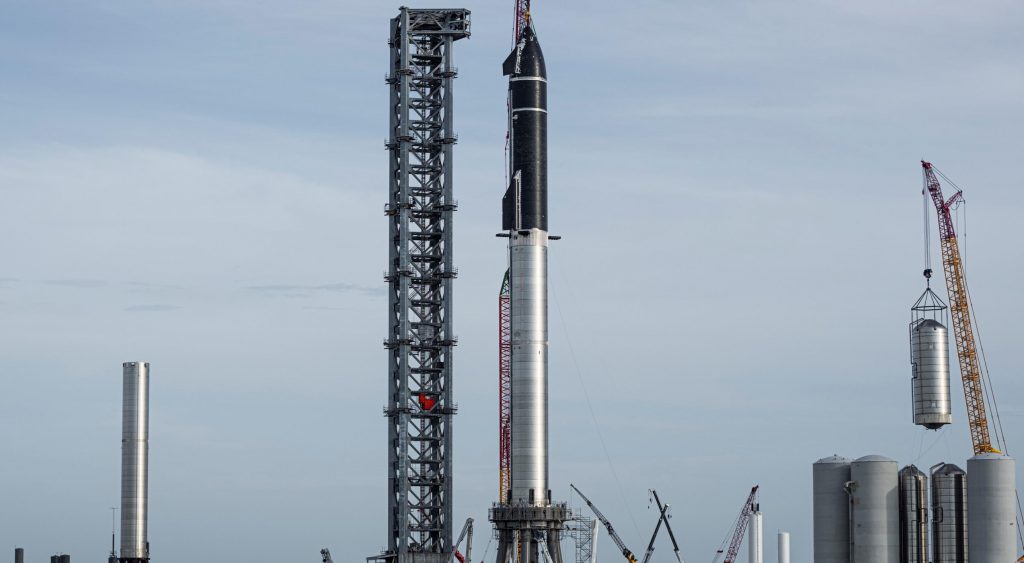
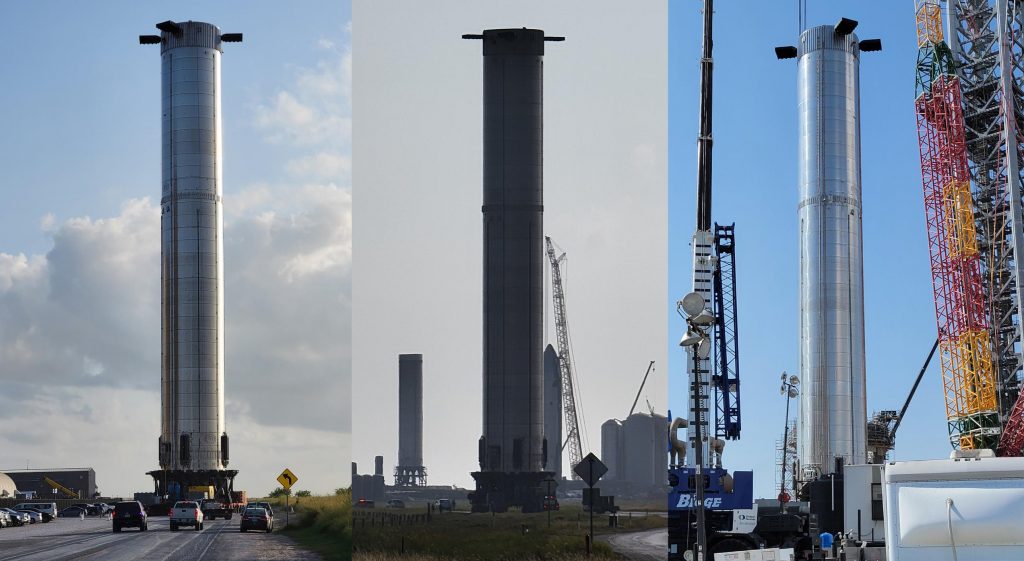
Three months (almost 14 weeks or 100 days) after the Super Heavy prototype’s second trip to the pad, SpaceX has yet to attempt to put the booster through a single proof test. There also appears to be a significant amount of work left to finish installing external ‘aerocovers’ and a heat shield meant to enclose all 29 of its Raptor engines. In the three-year history of Starbase, there isn’t a single prototype of the roughly two-dozen SpaceX has built, tested, and even flown that’s spent even half as long as Super Heavy B4 between apparent structural completion and its first test. Perhaps the fact that Booster 4 is a first-of-its-kind pathfinder explains SpaceX’s uncharacteristic sluggishness or reluctance to actually test the rocket.
In every other instance, SpaceX’s approach to Starship development has been to move incredibly quickly, build a large number of prototypes, and rapidly test those prototypes – often resulting in catastrophic failures. Data is gathered from those failures (SN1, SN3, SN4, SN8, SN9, SN10, SN11, and half a dozen smaller test tanks serve as examples), changes are made, and then the new and improved prototypes that follow repeat the process until SpaceX arrives at a successful design.
Super Heavy B4’s circuitous path has been almost nothing like those of its predecessors. That could also be partly explained by the unavailability of a stand or facilities capable of truly proof testing a Super Heavy, which necessitates a supply of around 3200 tons (7M lb) of liquid nitrogen (LN2; for a cryogenic proof test with full tanks), another 3200 tons of a combination of liquid methane (LCH4) and oxygen (LOx), and the ability to ignite – and survive – as many as 29 to 33 Raptor engines. The suborbital stands SpaceX has used to proof Starships and even Super Heavy Booster 3 don’t even have half the storage capacity required to fully test a booster and the mounts and their surroundings would likely be catastrophically damaged or destroyed by the thrust and blast created by dozens of Raptors.
Still, SpaceX could have theoretically put Booster 4 through a partial cryoproof and maybe fired up as many as nine Raptors at once – not a replacement for full proof testing but still plenty to ensure Super Heavy’s structural integrity and gather invaluable data on clustered Raptor performance. Instead, of course, Super Heavy B4 has sat at Starbase’s former landing zone for more than three months while teams removed engines, reinstalled engines, half-installed a full Raptor heat shield; and installed two of six or seven ‘aerocovers’ needed to protect heat exchangers, racks of pressure vessels, and hydraulic systems installed on the booster’s aft.
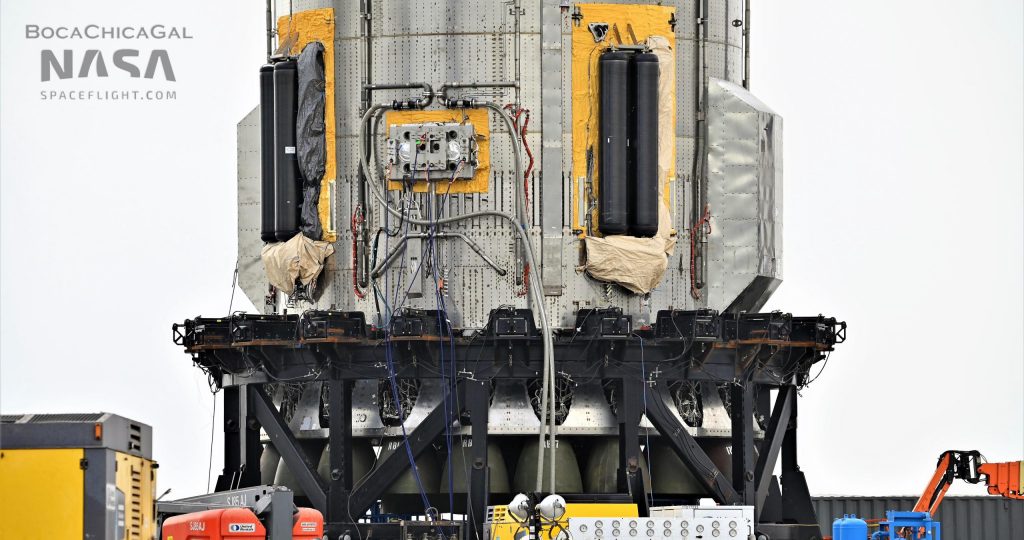
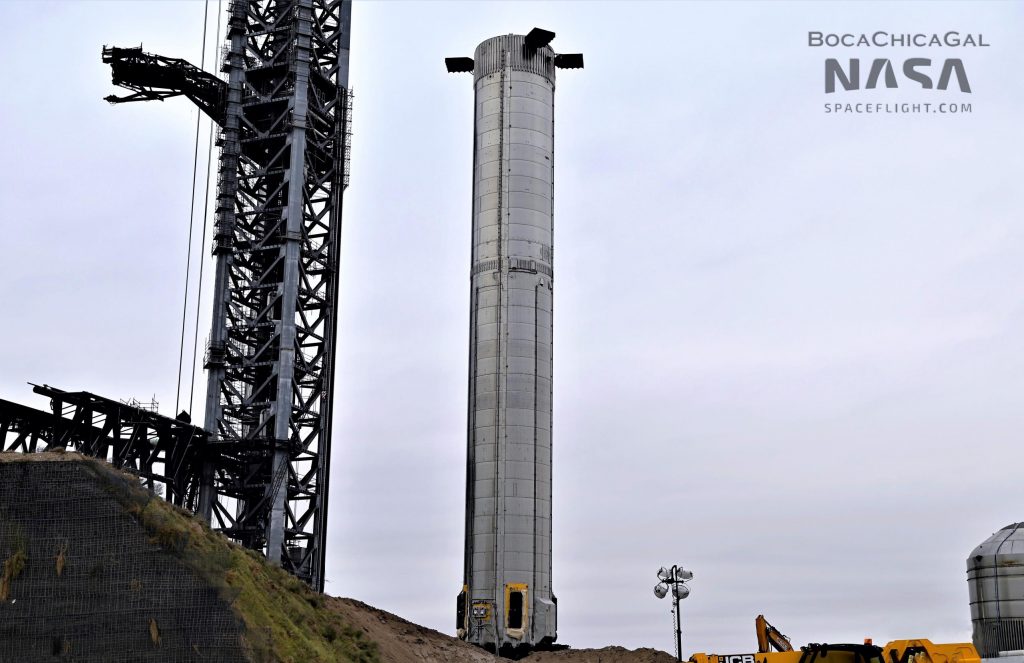
This is all to say that from the outside looking in, Booster 4’s path towards testing and flight has been almost entirely different from that of any other Starship prototype. While still quick in comparison with other launch vehicle development programs, relative to other Starship and Super Heavy prototypes, the rate of B4 progress has been far slower – strongly implying that something is seriously wrong with the booster, that SpaceX no longer feels that partial testing is worth the effort, that finishing Booster 4 just hasn’t been a priority for several months, or some combination of the above.
What that ultimately means is that it’s almost impossible to predict what Super Heavy B4’s future holds beyond the clear evidence that SpaceX will soon reinstall to reinstall it on an orbital launch mount that’s much closer to completion than it was the last time B4 was installed. At this point, it’s just as likely that the booster’s third launch mount installation will just be another mechanical fit test, though the hope is that it will kick off full-scale pneumatic and cryogenic proof testing. It could even culminate in the static fire of some or all of its 29 Raptor engines, which have been installed for several months.
News
Tesla UK sales see 14% year-over-year rebound in June: SMMT data
The SMMT stated that Tesla sales grew 14% year-over-year to 7,719 units in June 2025.
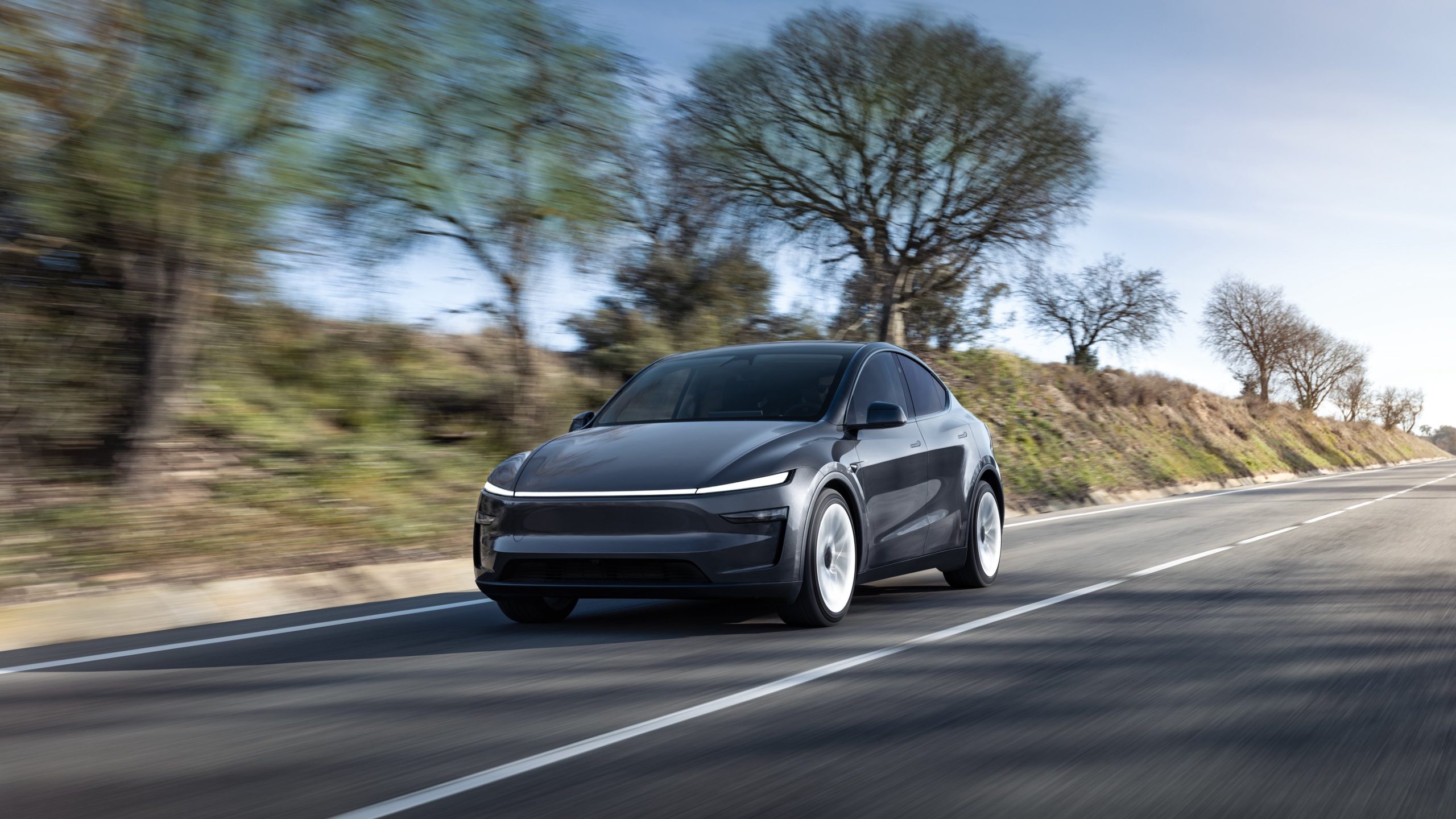
Tesla’s sales in the United Kingdom rose in June, climbing 14% year-over-year to 7,719 units, as per data from the Society of Motor Manufacturers and Traders (SMMT). The spike in the company’s sales coincided with the first deliveries of the updated Model Y last month.
Model Y deliveries support Tesla’s UK recovery
Tesla’s June performance marked one of its strongest months in the UK so far this year, with new Model Y deliveries contributing significantly to the company’s momentum.
While the SMMT listed Tesla with 7,719 deliveries in June, independent data from New AutoMotive suggested that the electric vehicle maker registered 7,891 units during the month instead. However, year-to-date figures for Tesla remain 2% down compared to 2024, as per a report from Reuters.
While Tesla made a strong showing in June, rivals are also growing. Chinese automaker BYD saw UK sales rise nearly fourfold to 2,498 units, while Ford posted the highest EV growth among major automakers, with a more than fourfold increase in the first half of 2025.
Overall, the UK’s battery electric vehicle (BEV) demand surged 39% to to 47,354 units last month, helping push total new car sales in the UK to 191,316 units, up 6.7% from the same period in 2024.
EV adoption accelerates, but concerns linger
June marked the best month for UK car sales since 2019, though the SMMT cautioned that growth in the electric vehicle sector remains heavily dependent on discounting and support programs. Still, one in four new vehicle buyers in June chose a battery electric vehicle.
SMMT Chief Executive Mike Hawes noted that despite strong BEV demand, sales levels are still below regulatory targets. “Further growth in sales, and the sector will rely on increased and improved charging facilities to boost mainstream electric vehicle adoption,” Hawes stated.
Also taking effect this week was a new US-UK trade deal, which lowers tariffs on UK car exports to the United States from 27.5% to 10%. The agreement could benefit UK-based EV producers aiming to expand across the country.
News
Tesla Model 3 ranks as the safest new car in Europe for 2025, per Euro NCAP tests
Despite being on the market longer than many of its rivals, the Tesla Model 3 continues to set the bar for vehicle safety.

The Tesla Model 3 has been named the safest new car on sale in 2025, according to the latest results from the Euro NCAP. Among 20 newly tested vehicles, the Model 3 emerged at the top of the list, scoring an impressive 359 out of 400 possible points across all major safety categories.
Tesla Model 3’s safety systems
Despite being on the market longer than many of its rivals, the Tesla Model 3 continues to set the bar for vehicle safety. Under Euro NCAP’s stricter 2025 testing protocols, the electric sedan earned 90% for adult occupant protection, 93% for child occupant protection, 89% for pedestrian protection, and 87% for its Safety Assist systems.
The updated Model 3 received particular praise for its advanced driver assistance features, including Tesla’s autonomous emergency braking (AEB) system, which performed well across various test scenarios. Its Intelligent Speed Assistance and child presence detection system were cited as noteworthy features as well, as per a WhatCar report.
Other notable safety features include the Model 3’s pedestrian-friendly pop-up hood and robust crash protection for both front and side collisions. Euro NCAP also highlighted the Model 3’s ability to detect vulnerable road users during complex maneuvers, such as turning across oncoming traffic.
Euro NCAP’s Autopilot caution
While the Model 3’s safety scores were impressive across the board, Euro NCAP did raise concerns about driver expectations of Tesla’s Autopilot system. The organization warned that some owners may overestimate the system’s capabilities, potentially leading to misuse or inattention behind the wheel. Even so, the Model 3 remained the highest-scoring vehicle tested under Euro NCAP’s updated criteria this year.
The Euro NCAP’s concerns are also quite interesting because Tesla’s Full Self-Driving (FSD) Supervised, which is arguably the company’s most robust safety suite, is not allowed for public rollout in Europe yet. FSD Supervised would allow the Model 3 to navigate inner city streets with only minimal human supervision.
Other top scorers included the Volkswagen ID.7, Polestar 3, and Geely EX5, but none matched the Model 3’s total score or consistency across categories. A total of 14 out of 20 newly tested cars earned five stars, while several models, including the Kia EV3, MG ZS, and Renault 5, fell short of the top rating.
Elon Musk
Why Tesla’s Q3 could be one of its biggest quarters in history
Tesla could stand to benefit from the removal of the $7,500 EV tax credit at the end of Q3.

Tesla has gotten off to a slow start in 2025, as the first half of the year has not been one to remember from a delivery perspective.
However, Q3 could end up being one of the best the company has had in history, with the United States potentially being a major contributor to what might reverse a slow start to the year.
Earlier today, the United States’ House of Representatives officially passed President Trump’s “Big Beautiful Bill,” after it made its way through the Senate earlier this week. The bill will head to President Trump, as he looks to sign it before his July 4 deadline.
The Bill will effectively bring closure to the $7,500 EV tax credit, which will end on September 30, 2025. This means, over the next three months in the United States, those who are looking to buy an EV will have their last chance to take advantage of the credit. EVs will then be, for most people, $7,500 more expensive, in essence.
The tax credit is available to any single filer who makes under $150,000 per year, $225,000 a year to a head of household, and $300,000 to couples filing jointly.
Ending the tax credit was expected with the Trump administration, as his policies have leaned significantly toward reliance on fossil fuels, ending what he calls an “EV mandate.” He has used this phrase several times in disagreements with Tesla CEO Elon Musk.
Nevertheless, those who have been on the fence about buying a Tesla, or any EV, for that matter, will have some decisions to make in the next three months. While all companies will stand to benefit from this time crunch, Tesla could be the true winner because of its sheer volume.
If things are done correctly, meaning if Tesla can also offer incentives like 0% APR, special pricing on leasing or financing, or other advantages (like free Red, White, and Blue for a short period of time in celebration of Independence Day), it could see some real volume in sales this quarter.
You can now buy a Tesla in Red, White, and Blue for free until July 14 https://t.co/iAwhaRFOH0
— TESLARATI (@Teslarati) July 3, 2025
Tesla is just a shade under 721,000 deliveries for the year, so it’s on pace for roughly 1.4 million for 2025. This would be a decrease from the 1.8 million cars it delivered in each of the last two years. Traditionally, the second half of the year has produced Tesla’s strongest quarters. Its top three quarters in terms of deliveries are Q4 2024 with 495,570 vehicles, Q4 2023 with 484,507 vehicles, and Q3 2024 with 462,890 vehicles.
-

 Elon Musk4 days ago
Elon Musk4 days agoTesla investors will be shocked by Jim Cramer’s latest assessment
-

 News1 week ago
News1 week agoTesla Robotaxi’s biggest challenge seems to be this one thing
-

 Elon Musk2 weeks ago
Elon Musk2 weeks agoFirst Look at Tesla’s Robotaxi App: features, design, and more
-

 News2 weeks ago
News2 weeks agoSpaceX and Elon Musk share insights on Starship Ship 36’s RUD
-

 News2 weeks ago
News2 weeks agoWatch Tesla’s first driverless public Robotaxi rides in Texas
-

 News1 week ago
News1 week agoWatch the first true Tesla Robotaxi intervention by safety monitor
-

 News2 weeks ago
News2 weeks agoTesla has started rolling out initial round of Robotaxi invites
-
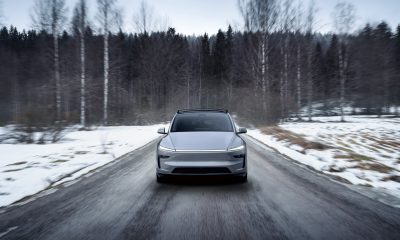
 Elon Musk2 weeks ago
Elon Musk2 weeks agoTesla to launch in India in July with vehicles already arriving: report


















